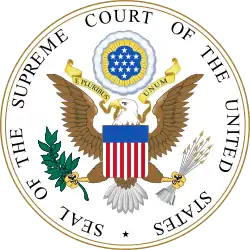Sackett v. Environmental Protection Agency (2023)
Sackett v. Environmental Protection Agency (Docket 21–454), also known as Sackett II (to distinguish it from the 2012 case), is a pending United States Supreme Court case related to the scope of the Clean Water Act.
| Sackett v. Environmental Protection Agency | |
|---|---|
 | |
| Full case name | Michael Sackett, et ux. v. Environmental Protection Agency, et al. |
| Docket no. | 21-454 |
| Argument | Oral argument |
| Questions presented | |
| Whether the United States Court of Appeals for the Ninth Circuit set forth the proper test for determining whether wetlands are "waters of the United States" under the Clean Water Act, 33 U.S.C. § 1362(7). | |
| Laws applied | |
| Clean Water Act | |
Background
Chantell and Michael Sackett purchased a 0.63-acre vacant lot near Priest Lake, Idaho, in 2004. They began construction of their home in the spring of 2007, after attaining building permits from local authorities. Shortly after, officials from the United States Environmental Protection Agency informed the Sacketts that their lot might be subject to regulation under the Clean Water Act, as it contained "wetlands" that were "navigable waters". The EPA directed the Sacketts to halt construction until they received a permit from the United States Army Corps of Engineers. The Sacketts received an administrative compliance order from the EPA in the fall of 2007. In 2008, they sued under the Administrative Procedure Act. The lower courts held EPA compliance orders were not subject to the APA, but the Supreme Court reversed in a 2012 decision of the same name.
In the 2006 Rapanos v. United States decision, the Supreme Court decided the scope of the Clean Water Act in a 4–1–4 opinion. Justice Anthony Kennedy's solo concurrence offered a more sweeping interpretation of the Act's jurisdiction over navigable waters; Justice Antonin Scalia's plurality offered the narrowest interpretation. The Sacketts argued to the United States District Court for the District of Idaho on remand from the Supreme Court that their land was not subject to the CWA. In 2019, the district court applied Justice Kennedy's test and held the lot was regulated by the CWA. The United States Court of Appeals for the Ninth Circuit affirmed in August 2021, and rejected an attempt by the EPA to moot the litigation by withdrawing the compliance order.
The Sacketts filed a petition for a writ of certiorari.[1]
Supreme Court
Certiorari was granted in the case on January 24, 2022.
References
- Howe, Amy (January 24, 2022). "Justices take up cases on power of district courts and regulation of wetlands". SCOTUSblog. Retrieved January 24, 2022.